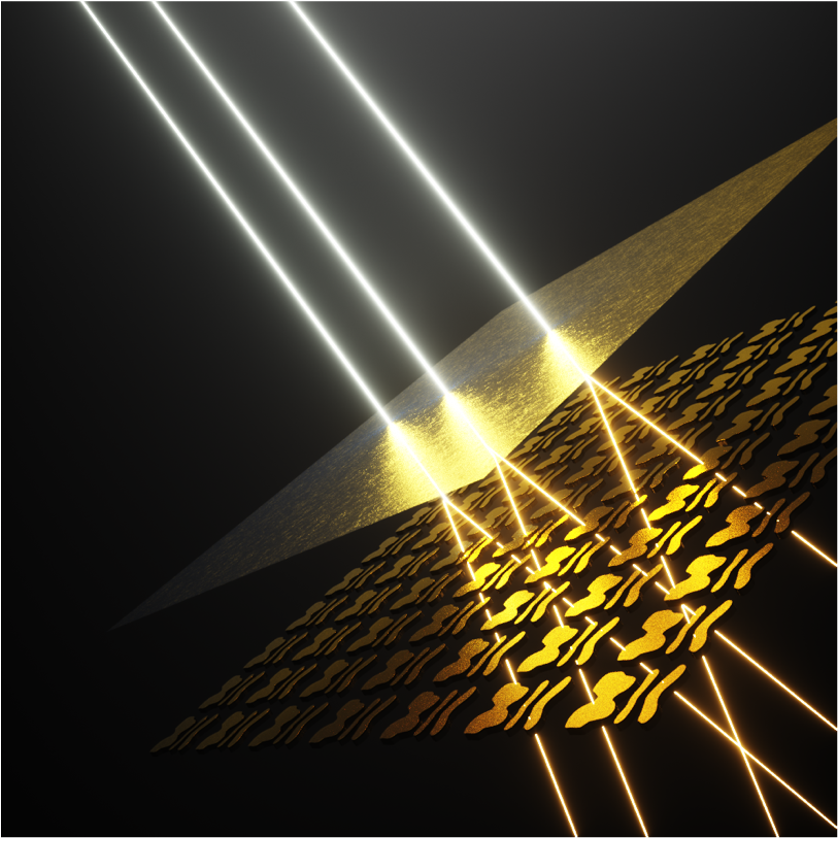
Researchers at the University of Pennsylvania, AMOLF, and the City University of New York (CUNY) have created a surface with a nanostructure capable of solving mathematical equations.
Powered by light and free of electronics, this discovery introduces exciting new prospects for the future of computing.
Nader Engheta, H. Nedwill Ramsey Professor of Electrical and Systems Engineering at the University of Pennsylvania School of Engineering and Applied Science, is a visionary figure in optics and in electromagnetic platforms. For the last two decades, he has created theory and designed experiments to make electromagnetic and optical devices that operate at the fastest rate in the universe.
Engheta is the founder of the influential field of “optical metatronics.” He creates materials that interact with photons to manipulate data at the speed of light. Engheta’s contribution to this study marks an important advance in his quest to use light-matter interactions to surpass the speed and energy limitations of digital electronics, bringing analog computing out of the past and into the future.
“I began the work on optical metatronics in 2005,” says Engheta, “wondering if it were possible to recreate the elements of a standard electronic circuit at nanoscale. At this tiny size, it would be possible to manipulate the circuit with light, rather than electricity. After achieving this, we became more ambitious, envisioning collections of these nanocircuits as processors. In 2014, we were designing materials that used these optical nanostructures to perform mathematical operations, and in 2019, we anted up to entire mathematical equations using microwaves. Now, my collaborators and I have created a surface that can solve equations using light waves, a significant step closer to our larger goals for computing materials.”
The study, recently published in Nature Nanotechnology, demonstrates the possibility of solving complex mathematical problems and a generic matrix inversion at speeds far beyond those of typical digital computing methods.
The solution converges in about 349 femtoseconds (less than one trillionth of a second), orders of magnitude faster than the clock speed of a conventional processor.
A Future in Analog
The digital computers we rely on today are proving too slow and power-hungry to keep up with the fast pace of innovation. Growing demands for technologies that rely on computation-heavy operations such as machine learning, artificial intelligence and computer vision strain the capacities of digital processing power and energy efficiency.
The pressure these technologies place on digital hardware is driving a surprising renewal of interest in analog computing.
Long outdated, analog computers communicate with a variety of wave patterns rather than the binary switching that digital computers use to store, process and present data. But being bulky, inefficient, noisy and non-programmable, analog computers fell out of favor in the final decades of the twentieth century as the digital revolution gathered steam.
Now, scientific advances offer elegant solutions to most of the drawbacks of analog systems, and engineers are at work devising new features for hardware that harness the speed and energy advantages of waves over 1s and 0s.
A major benefit of using light waves to perform specific computing tasks is that they can operate at much higher speeds than electronic methods, traveling through very thin nanostructured surfaces called metasurfaces.
In addition, optical analog processing can be more energy efficient than electronic methods, since it does not generate heat the way electronic circuits do. This makes it well-suited for use in high-performance computing applications where speed and energy efficiency are priorities.
“In self-driving cars, for example, image detection and processing take up a lot of computing time,” says Andrea Cordaro, AMOLF doctoral fellow and lead author of the study. “In an earlier paper we showed that it is possible to use an optical metasurface for very fast edge detection in an input image. Detecting the edges of objects — like cars, people, etc. — is the first step in image processing in many applications. Performing this step optically can save processing time and energy.”
Matrix Inversions, and Quick
What kind of mathematical operations would benefit from this dramatic speed-up?
Linear inverse problems are constant requirements in many fields, including engineering, science and economics. They are called “inverse problems” because the goal is to invert the process that generates the data to obtain the solution. These problems typically involve matrix inversions, a relatively slow mathematical operation.
Here, Engheta and collaborators demonstrate a thin dielectric nanostructure that performs optical matrix inversions and use them to solve a special kind of equation called “Fredholm integral equations of the second kind.”
Surface geometry is key. This 2D material must be structured in a particular way for it to calculate the given equation for a theoretically infinite number of inputs. Using a special optimization technique to design the unit cell of the nanostructured array, called “metagrating,” the team implements the desired matrix multiplication corresponding to the mathematical problem of interest. Next, a semi-transparent mirror is incorporated into the sample to continuously send signal back to the nanostructures. Each time, the signal is multiplied by the metagrating scattering matrix.
“In digital computers,” says Engheta, “software can reprogram the same circuits to do different things. For now, our material is fixed in one given structure. For the future, I envision a material like this one that can not only solve an equation, but also rewrite itself, solve another equation, erase itself, and so on, so it can serve as computer hardware. And all of this optically, at the speed of light.”
This release was produced in collaboration with AMOLF.
